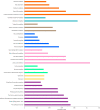Transcriptomic changes induced by applications of a commercial extract of Ascophyllum nodosum on tomato plants
- PMID: 35577794
- PMCID: PMC9110418
- DOI: 10.1038/s41598-022-11263-z
Transcriptomic changes induced by applications of a commercial extract of Ascophyllum nodosum on tomato plants
Abstract
Extracts of Ascophyllum nodosum are commonly used as commercial biostimulants in crop production. To further understand the seaweed extract-induced phenomena in plants, a transcriptomic study was conducted. RNA-seq differential gene expression analysis of tomato plants treated with a commercial A. nodosum extract formulation (Stimplex) revealed the up-regulation of 635 and down-regulation of 456 genes. Ontology enrichment analysis showed three gene categories were augmented, including biological processes, cellular components, and molecular functions. KEGG pathway analysis revealed that the extract had a strong influence on the expression of genes involved in carbon fixation, secondary metabolism, MAPK-signalling, plant hormone signal transduction, glutathione metabolism, phenylpropanoid and stilbenoid metabolism, and plant-pathogen interactions. qRT-PCR validation analysis using 15 genes established a strong correlation with the RNA sequencing results. The activities of defence enzymes were also significantly enhanced by seaweed extract treatment. Furthermore, AN-SWE treated tomato plants had significantly higher chlorophyll and growth hormone content and showed improved plant growth parameters and nutrient profiles than the control. It is postulated that seaweed extract-induced gene regulation was responsible for favourable plant responses that enabled better growth and tolerance to stress conditions. This study provides evidence at the transcriptomic level for the positive effects of foliar application of the Ascophyllum nodosum extract (Stimplex) observed in treated tomato plants.
© 2022. The Author(s).
Conflict of interest statement
The authors declare no competing interests.
Figures








Similar articles
-
Biostimulatory activities of Ascophyllum nodosum extract in tomato and sweet pepper crops in a tropical environment.PLoS One. 2019 May 14;14(5):e0216710. doi: 10.1371/journal.pone.0216710. eCollection 2019. PLoS One. 2019. PMID: 31086398 Free PMC article.
-
Comparative Transcriptome Analysis of Two Ascophyllum nodosum Extract Biostimulants: Same Seaweed but Different.J Agric Food Chem. 2016 Apr 13;64(14):2980-9. doi: 10.1021/acs.jafc.6b00621. Epub 2016 Apr 1. J Agric Food Chem. 2016. PMID: 27010818
-
Ascophyllum nodosum extract biostimulants and their role in enhancing tolerance to drought stress in tomato plants.Plant Physiol Biochem. 2018 May;126:63-73. doi: 10.1016/j.plaphy.2018.02.024. Epub 2018 Mar 2. Plant Physiol Biochem. 2018. PMID: 29501894
-
Ascophyllum nodosum-Based Biostimulants: Sustainable Applications in Agriculture for the Stimulation of Plant Growth, Stress Tolerance, and Disease Management.Front Plant Sci. 2019 May 29;10:655. doi: 10.3389/fpls.2019.00655. eCollection 2019. Front Plant Sci. 2019. PMID: 31191576 Free PMC article. Review.
-
Ascophyllum nodosum as a nutrient supporting oral health in dogs and cats: a review.Pol J Vet Sci. 2023 Sep 20;26(3):511-520. doi: 10.24425/pjvs.2023.145053. Pol J Vet Sci. 2023. PMID: 37727971 Review.
Cited by
-
Forest tree extracts induce resistance to Pseudomonas syringae pv. tomato in Arabidopsis.Sci Rep. 2024 Oct 21;14(1):24726. doi: 10.1038/s41598-024-74576-1. Sci Rep. 2024. PMID: 39433573 Free PMC article.
-
Transcriptome, Biochemical and Phenotypic Analysis of the Effects of a Precision Engineered Biostimulant for Inducing Salinity Stress Tolerance in Tomato.Int J Mol Sci. 2023 Apr 10;24(8):6988. doi: 10.3390/ijms24086988. Int J Mol Sci. 2023. PMID: 37108156 Free PMC article.
-
Transcriptome-wide modulation by Sargassum vulgare and Acanthophora spicifera extracts results in a prime-triggered plant signalling cascade in tomato and sweet pepper.AoB Plants. 2022 Oct 6;14(6):plac046. doi: 10.1093/aobpla/plac046. eCollection 2022 Nov. AoB Plants. 2022. PMID: 36483312 Free PMC article.
-
Facilitating Growth of Maize (Zea mays L.) by Biostimulants: A Perspective from the Interaction between Root Transcriptome and Rhizosphere Microbiome.J Agric Food Chem. 2024 Feb 21;72(7):3415-3426. doi: 10.1021/acs.jafc.3c09062. Epub 2024 Feb 7. J Agric Food Chem. 2024. PMID: 38325817 Free PMC article.
-
Rice-Magnaporthe transcriptomics reveals host defense activation induced by red seaweed-biostimulant in rice plants.Front Genet. 2023 Jun 23;14:1132561. doi: 10.3389/fgene.2023.1132561. eCollection 2023. Front Genet. 2023. PMID: 37424731 Free PMC article.
References
-
- Du Jardin P. Plant biostimulants: Definition, concept, main categories and regulation. Sci. Hortic. (Amsterdam) 2015;196:3–14. doi: 10.1016/j.scienta.2015.09.021. - DOI
-
- De Saeger J, et al. Toward the molecular understanding of the action mechanism of Ascophyllum nodosum extracts on plants. J. Appl. Phycol. 2020;32:573–597. doi: 10.1007/s10811-019-01903-9. - DOI
Publication types
MeSH terms
Substances
LinkOut - more resources
Full Text Sources

